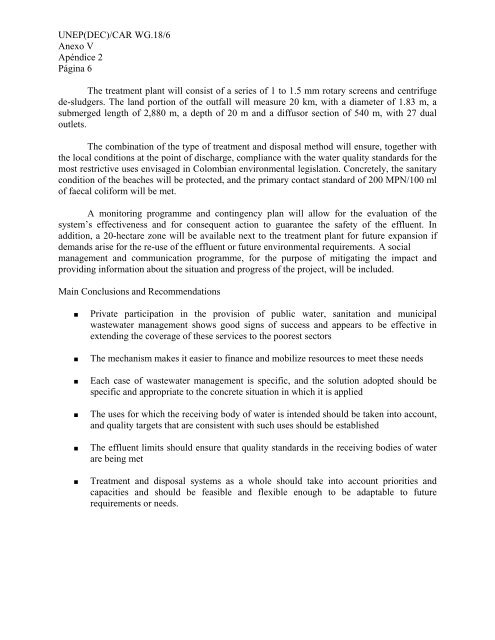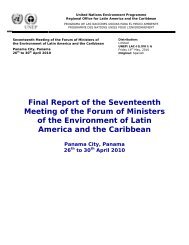Caribbean Environment Programme - UNEP
Caribbean Environment Programme - UNEP
Caribbean Environment Programme - UNEP
Create successful ePaper yourself
Turn your PDF publications into a flip-book with our unique Google optimized e-Paper software.
<strong>UNEP</strong>(DEC)/CAR WG.18/6<br />
Anexo V<br />
Apéndice 2<br />
Página 6<br />
The treatment plant will consist of a series of 1 to 1.5 mm rotary screens and centrifuge<br />
de-sludgers. The land portion of the outfall will measure 20 km, with a diameter of 1.83 m, a<br />
submerged length of 2,880 m, a depth of 20 m and a diffusor section of 540 m, with 27 dual<br />
outlets.<br />
The combination of the type of treatment and disposal method will ensure, together with<br />
the local conditions at the point of discharge, compliance with the water quality standards for the<br />
most restrictive uses envisaged in Colombian environmental legislation. Concretely, the sanitary<br />
condition of the beaches will be protected, and the primary contact standard of 200 MPN/100 ml<br />
of faecal coliform will be met.<br />
A monitoring programme and contingency plan will allow for the evaluation of the<br />
system’s effectiveness and for consequent action to guarantee the safety of the effluent. In<br />
addition, a 20-hectare zone will be available next to the treatment plant for future expansion if<br />
demands arise for the re-use of the effluent or future environmental requirements. A social<br />
management and communication programme, for the purpose of mitigating the impact and<br />
providing information about the situation and progress of the project, will be included.<br />
Main Conclusions and Recommendations<br />
<br />
<br />
<br />
<br />
<br />
<br />
Private participation in the provision of public water, sanitation and municipal<br />
wastewater management shows good signs of success and appears to be effective in<br />
extending the coverage of these services to the poorest sectors<br />
The mechanism makes it easier to finance and mobilize resources to meet these needs<br />
Each case of wastewater management is specific, and the solution adopted should be<br />
specific and appropriate to the concrete situation in which it is applied<br />
The uses for which the receiving body of water is intended should be taken into account,<br />
and quality targets that are consistent with such uses should be established<br />
The effluent limits should ensure that quality standards in the receiving bodies of water<br />
are being met<br />
Treatment and disposal systems as a whole should take into account priorities and<br />
capacities and should be feasible and flexible enough to be adaptable to future<br />
requirements or needs.

















